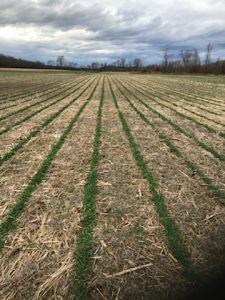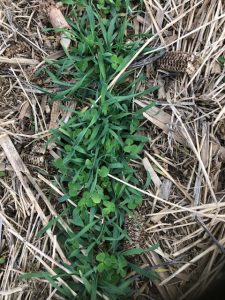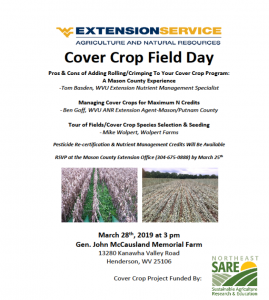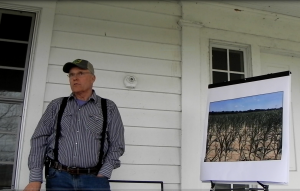Final report for ONE16-289C
Project Information
Promotion of cover crops in West Virginia was the premise for this NE SARE funded project. We worked with two lead farmers to develop or evaluate cover cropping techniques that best fit their operations. Our Commodity Crop farmer evaluated rolled and crimped cover crops in comparison with the more typically terminated standing cover crops. This trial resulted in comparable yields but the rolled/crimped treatment caused the corn planter to clog with matted rye cover crop, slowing field operations. To eliminate problems with planting into high density cover crops this farmer has now developed a cover crop program based on 30 inch rows, reducing spring corn planting problems and increasing speed of cover crop planting in the fall. We selected a vegetable producer who evaluated cover crops in a raised bed no-till production system, and cover crops with no-till in high tunnel production. The raised bed no-till/cover crop trial was initially not successful due to late seeding of cover crops and learning to use the WVU no-till drill. In Year Two, the cover crop was drilled on the beds with successful emergence and growth, and was then smothered the following spring with the silage tarp before the vegetables were planted in the beds. No-till with cover cropping was new to the farmer, and after these successful harvests this system will be added to his remaining high tunnels. Promotion of these novel cover crop systems evaluated by these two farmers has been undertaken by WVU Extension and also by our commodity crop farmer, who has been invited to speak at the Mid-Ohio Grain Conference. His talk is titled "Experiences in 30 years in no till and 10 years of cover cropping." Our vegetable producer is a lead farmer in our North Central area of West Virginia and a key farmer-to-farmer educator in the area of soil health and cover cropping in vegetable production systems.
With this project, we attempted to evaluate cover crop use in two different systems in West Virginia. In specialty crop production, we evaluated winter and summer cover crops established on permanent beds for open-field and protected culture. On commodity grain farms, we compared rolled green cover crop to standing cover crop with corn and soybean production.
We demonstrated the use of the Roller Crimper Technology on three farms – a commodity grain farm, an organic dairy farm and a vegetable farm. One or more educational events will accompany each of the demonstration/trials conducted on the three different farms during the fall of the second year of the grant period, to discuss results from two years of trials and bring a group of farmers out to see the early establishment of fall cover crop plantings.
Initial outreach efforts in West Virginia (WV) have sought to demonstrate the use of cover crops for good soil health to increase yields, profitability and water quality benefits. Despite this, most specialty and commodity crop producers in West Virginia have not successfully adopted cover cropping as a Best Management Practice. Crop producers in WV are typically a diverse mix of small commodity crop farms, or specialty crops producers using permanent raised beds for high-tunnel or open field production. In an effort to serve the diverse cropping landscape in WV, the WV participants of the Northeast SARE March 2016 Cover Crop Conference conducted field trials, field demonstrations, and accompanying farmer field days on vegetable and commodity grain enterprises to help increase awareness, understanding, and adoption of cover crops as part of the cropping systems to improve soil health. This initiative has two parts – Evaluating and Demonstrating Cover Crops for:
- Crop Production on a Conventional Commodity Crop Farm and an Organic Dairy; and
- Specialty Crop Production on Permanent Raised Beds for High Tunnels and Open-Field Systems
Cooperators
- (Educator)
Research
Accomplishments
I. Vegetable Producer, Jeff Sickler Farm
2016 Vegetable Farm Activity
Cover crops were established in open-field plots at Sickler Farms in Barbour County, WV on October 20, 2016. The cover crop mix included triticale, tillage radish, winter pea and crimson clover. Each legume species was inoculated prior to seeding and broadcast-seeded followed by cultipacking. Rainfall occurred within 24 hours after seeding. Emergence was observed 10 days after seeding and in the spring, 2017, the field will be partitioned into 5 permanent beds for no-till vegetable demonstration and production.
On October 26, 2016, cover crops were established within a high tunnel at Sickler Farms. Triticale, crimson clover and winter pea were broadcast-seeded followed by raking the seed lightly and overhead watering. One half of the growing zone was subsoiled using a broadfork. Emergence was observed within 10 days. Beginning in March, 2017, the cover crops will be cut and used to establish permanent beds for crop production and demonstration within the high tunnel.
2017 Vegetable Farm Activity
Winter cover crops were established in Fall, 2016 at Sickler Farms in Barbour County West Virginia. Sickler Farms is a highly diversified specialty crop farm. However, the farm topography makes most of the field plots vulnerable to soil erosion. Therefore, integrating cover crops within the rotation pattern for this farm will significantly improve the overall efficiency of the farm. In addition the farm will serve as a case study for a small, diversified farm which successfully uses cover crops. Species evaluated included winter pea, crimson clover and triticale. The cover crops were seeded in open-field and high tunnels in Mid to late October, 2016. Field plots had poor stand establishment of the winter cover crop species and were planted in spring oats the following spring 2017. The high tunnel plots, however, had significantly greater stand establishment and vigor of all cover crop species. The cover crops within the high tunnels were covered with black, woven groundcover fabric in early April (Figure 1) and subsequently planted with cantaloupes in late April. The field plots were also covered when the spring oats reached a height of 10 inches. The oats were mowed with a rotary mower and the woven fabric tarps placed over the field for planting watermelon and cantaloupe in late May, 2017 (Figure 2). Harvest of cantaloupes within the high tunnel commenced in late June while field plots were harvested in late August.
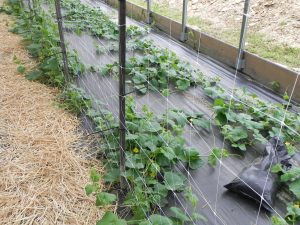
Figure 1. Cover crop in High Tunnel covered with groundcover fabric
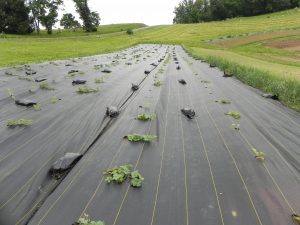
Figure 2. Cantaloupes planted into fabric after Spring Oats cover crop
A summer cover crop was evaluated in field plots. Sunhemp was seeded in early July, 2017 on a field which was scheduled to be planted in annual strawberries in late August. The sunhemp was mowed in mid-August, the soil tilled, rebedded and planted in strawberries (Figure 3).
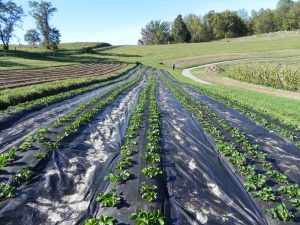
Figure 3. Sunhemp cover crop planted to strawberries
In Fall, 2017, the field which was previously dedicated to demonstrating a permanent bed, no-till system was re-bedded, rolled and drilled with winter pea, crimson clover and triticale in mid-October (Figure 4). Three weeks later, the high tunnel plots (non-raised beds) were broadcast seeded.
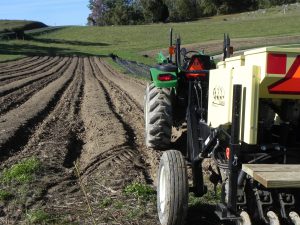
Figure 4. Cover crop mix planted with no-till drill
2018 Vegetable Farm Activity
Late spring of 2018 the no-till planted cover crop with winter pea, crimson clover and triticale was terminated using geotextile fabric and a cabbage variety trial was established. Due to excessive rainfall this crop was damaged and no data was collected. In the high tunnel the cover crop was also smothered with geotextile fabric and a pepper and half runner bean crops were planted. In July of 2018 a No-till vegetable production twilight meeting occurred. Eight commercial vegetable producers attended with discussion focusing on no-till, cover crops and cropping methods. A no-till tranplanter was demonstrated at this meeting. This fall, Sickler farms made use of the WVU no-till drill to establish cover crops in the same location, the permanent raised beds that grew the summer cabbage crop. A different cover crop establishment method was demonstrated in the Sicklers high tunnel. A summer Tomato crop had been mulched using oat straw. This straw remained in good condition in the high tunnel and after the tomato plants were removed the cover crop seed was broadcast into the mulch and the house was irrigated to sprout the cover crop seed. The oat straw enabled good seedling establishment and the cover crop is thriving this winter. This farmer has an increased understanding of no-till vegetable production with cover crops. This no-till/cover crop adoption occurred because of continuous WVU Extension Service Guidance, the availability of the WVU No-Till Drill and the use of geotextile fabric to terminate the cover crops without herbicide or tillage and establish the main season crop into the fabric covered raised beds or high tunnel areas.
2019 Vegetable Farm Activity
Jeff and Lisa Sickler continued with cover crop/ no-till practices both inside the high tunnel environment and outside on the no-till contour strip that has been used for the past years demonstration. In the attached slide presentation there are examples of new cover crop termination method. This method uses silage tarps to physically smother the cover crop providing a dead mulch that Jeff then planted into without pre-plant tillage activity. Project funds were provided for Jeff to evaluate this system and he followed the prescribed steps using sand bags to maintain good plant cover and a seal to generate heat under the tarp to accelerate the die down of the cover crops
Figure 11. Silage Tarp applied to growing cover crop in High Tunnel
II. Commodity Crop Grower, Mike Wolpert
2016 Commodity Crop Farm Activity
A cereal rye cover crop was established on Mike Wolpert’s farm in Mason County WV. Due to commodity crop prices for corn grain he has switched his cropping for 2017 to soybeans. The cereal rye will be rolled and crimped or left standing with the soybeans planted into the two treatments. A USDA roller crimper has been loaned to WVU. A quick attachment modification unit has been fabricated so the loaned roller crimper can be used on Mike Wolpert’s tractor.
2017 Commodity Crop Farm Activity
Cereal Rye grain was planted to a rental field in October 2016 at 2 bu. Per acre. The following spring when the rye cover crop had reached the milk stage of grain fill the cover crop was rolled and a soybean crop was planted (Figure 5). Each treatment was replicated four times.
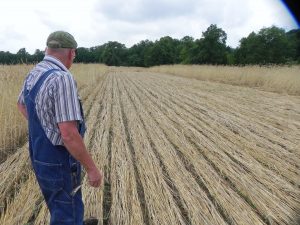
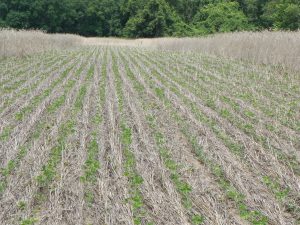
Figure 5. Rolled/Crimped Rye cover crop with unrolled treatments, 3 replications
Crop emergence was good for both rolled and unrolled cover crop treatments. Deer pressure on the emerged seedling began to become evident as the crop developed with the majority of the damage being done to the rolled/crimped sections of the field (Figure 6).
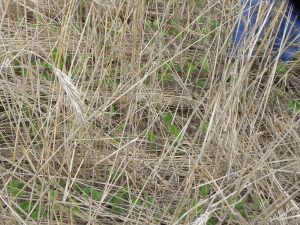
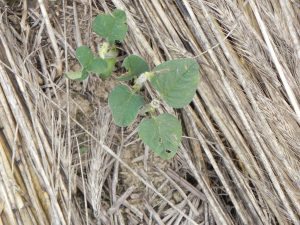
Figure 6. Damaged soybean seedlings in rolled cover crops
To determine soil moisture treatment effects a set of Hobo data loggers with 8 soil moisture meters and a rain gauge. Four meters were placed in a rolled/crimped plot and the other four meters were placed in the soil in the unrolled treatment plot (Figure 7). These instruments were purchased without project funds, costs to the PI was $3,200.
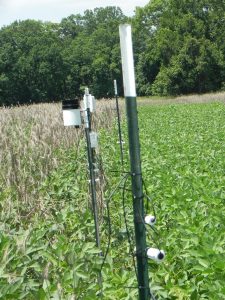
Figure 7. Data loggers, rain gauge and soil moisture meter cables on t-posts
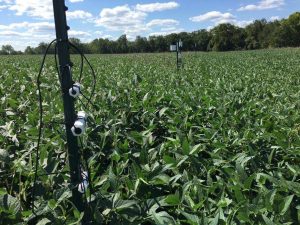
August 23rd photo above of rolled/crimped treatment soybeans showing no moisture stress. Rainfall data from the Hobo units showed optimum soil moisture for both rolled and unrolled plots with timely rains occurring throughout the growing season. Plot were harvested November 12, 2017 with a GPS enabled combine. Plot Data was shared by Mike (Figure 8).
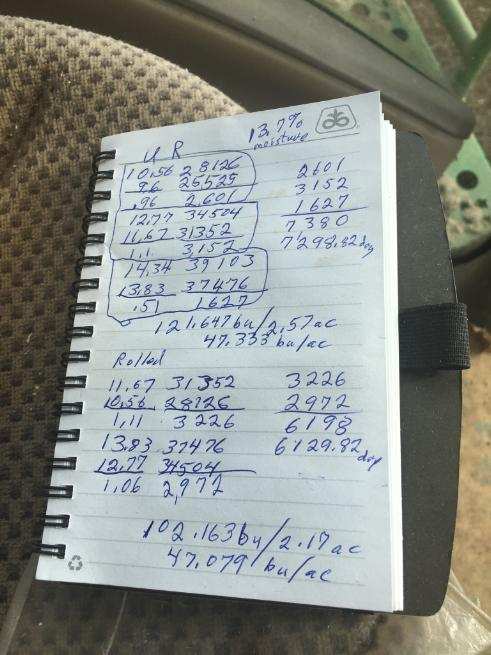
Figure 8. Combine soybean harvest yield data
2018 Commodity Crop Farm Activity
No cover crop demonstration work occurred during the fall of 2017 and summer of 2018 due to loss of support person in Mason county. During the fall of 2018 the commodity crop farmer established a annual rye cover crop on field corn before harvest. This was accomplished using an aerial seeding method. The planting was successful and we are planning a field day at that field prior to spring planting to demonstrate this seeding method to area farmers
2019 Commodity Crop Farm Activity
The Farmer Mike Wolpert provided an opportunity for other row crop farmers in Mason County to evaluate the aerial seeding that had occurred during the fall of 2018. This cover crop field day was a success with multiple topics covered including session lead by Mike about his seeding efforts.
During the fall Mike decided to establish his cover crops in a new manner. He had experienced a great deal of trouble with corn planting into standing green cover crop. The planter repeatedly became clogged with plant material and he would have to clear this and resume. To avoid this from occurring this spring, Mike decided to plant his cover crop mix, 25lb cereal rye, 5lb crimson clover and 1lb rape in 30 inch rows using his corn planter (Figure 9) instead of the grain drill. Using this method he was able to plant 150 acres in 3 days with a 15 mile move of the equipment between fields. He also drilled a 22 acre field in the normal fashion and that took an entire day.
Figure 9. Emerged Cover Crop planted on 30 Inch rows
Figure 10. Close up of Emerged cover crop pictures taken middle of January 2020
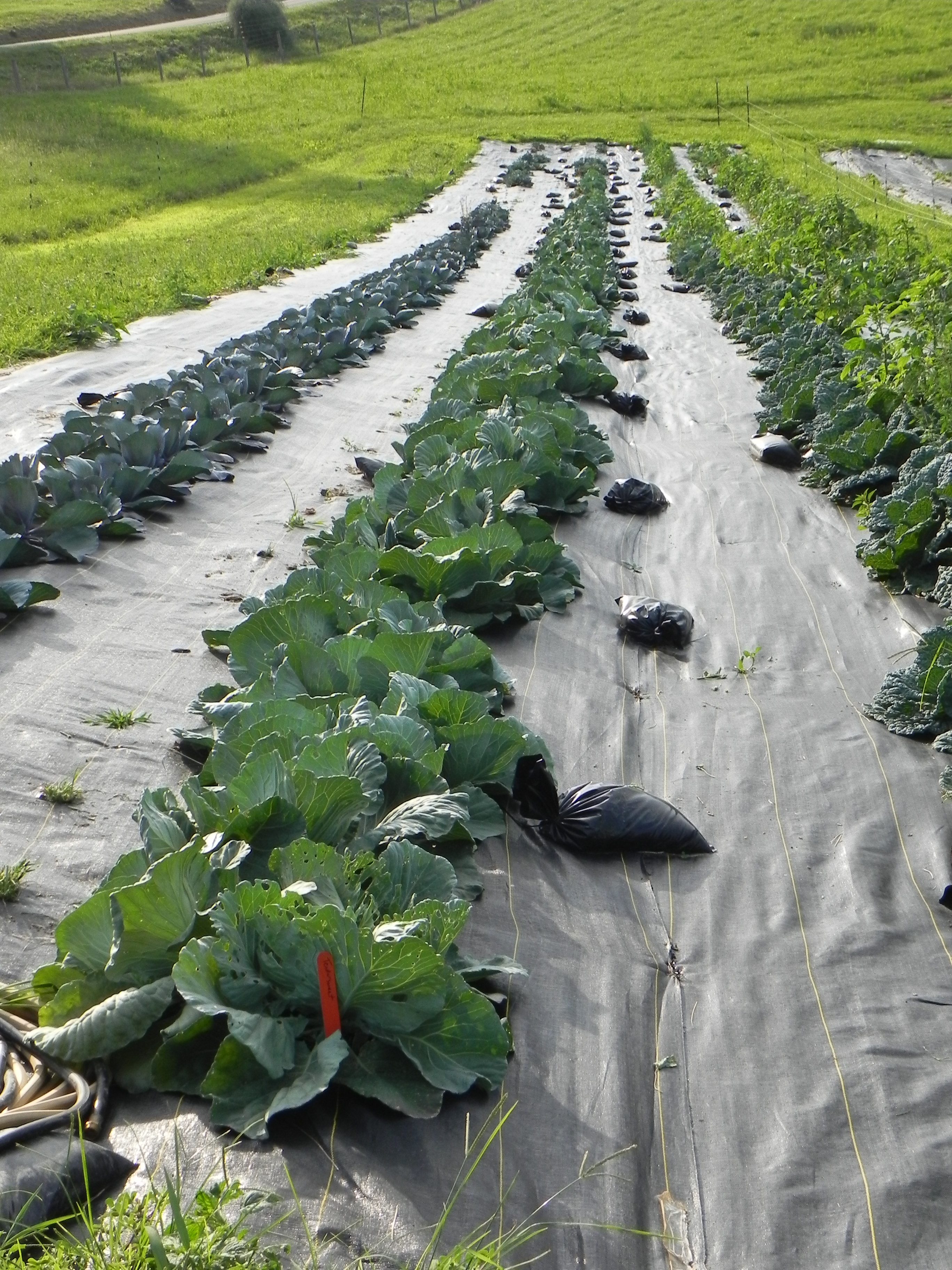
2018 cabbage crop on permanent raised bed
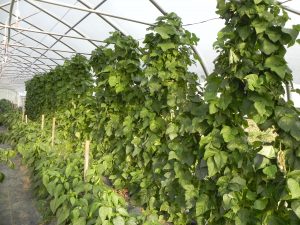
2018 half runner beans and pepper plants in high tunnel
Twilight meeting held at Sickler Farm in July 2018
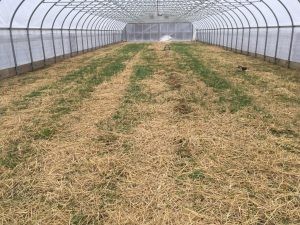
Cover crop seeding into oat straw mulch in high tunnel
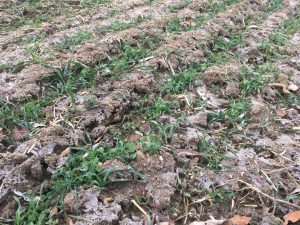
2018 no-till drill cover crop into permanent raised beds after cabbage harvest
Our Commodity Crop farmer evaluated rolled and crimped cover crops in comparison with the more typically terminated standing cover crops. This trial resulted in comparable yields but the rolled/crimped treatment caused the corn planter to clog with matted rye cover crop, slowing field operations. To eliminate problems with planting into high density cover crops this farmer has now developed a cover crop program based on 30 inch rows, reducing spring corn planting problems and increasing speed of cover crop planting in the fall.
Our vegetable producer evaluated cover crops in a raised bed no-till production system, and cover crops with no-till in high tunnel production. The raised bed no-till/cover crop trial was initially not successful due to late seeding of cover crops and learning to use the WVU no-till drill. In Year Two, the cover crop was drilled on the beds with successful emergence and growth, and was then smothered the following spring with the silage tarp before the vegetables were planted in the beds. No-till with cover cropping was new to the farmer, and after these successful harvests this system will be added to his remaining high tunnels.
Education & Outreach Activities and Participation Summary
Participation Summary:
Two publications were purchased for distribution to project participants:
Cover Cropping Triple-Play Package
These three publications were purchased and distributed to farmers and Agricultural Educators attending the March 2019 cover crop field day. The remaining publications were distributed to members of the Mason County Grain Growers Association that were not able to attend the field day.
Purdue Midwest Cover Crops Field Guide
This publication is targeted to row crop agriculture and provides cover crop descriptions, seeding rates, winter hardiness in a pocket book size so it can been carried with the farmer to the field. Copies of this publication were purchased and distributed to farmers at a March 2019 field day and to agricultural educators at the annual WVU County Agricultural Agents Spring Meeting in April of 2019.
Successfully Using Cover Crops within High Tunnels in West Virginia Slide Deck
The slide presentation, "Successfully Using Cover Crops within High Tunnels in West Virginia," incorporates the new cover crop methods evaluated by this Northeast SARE project with other cover crop trials, and demonstrations Dr. Jett and others have worked in over the years. Use of cover crops in high tunnels is novel and WV growers are adopting this conservation practice. The use of silage tarps to smother the cover crop biomass allows for an additional soil conservation practice to be added. This cover crop project evaluated no-till vegetable production practice. The combination of cover crops with no-till provides additional soil health benefits if this system can be shown to be achievable by produce farmers. This presentation will provide a concise teaching tool to increase adoption of cover crop and no-till for WV high Tunnel vegetable growers.
Grow Cover Crops within High Tunnels Fact Sheet
The material presented in this document is a direct result of this project's funding. Data presented was collected during 2019 from cooperating farmer Jeff Sickler's farm fields and high tunnel growing areas. This fact sheet is in a peer review process. A final published version is expected summer of 2020. This publication will be available at the WVU Extension Agriculture and Natural Resources website.
March 28, 2019 Cover Crop Field Day in Mason County WV. The above picture taken at our spring cover crop field day shows our cooperating corn and soybean farmer Mike Wolpert discuss with the group his experiences with adding cover crops to his crop rotation. This field included a cover crop walk in a field where Mike had two CC seeding methods.
2020 Mid-Ohio Valley Grain Crops Conference. Mike Wolpert gave a presentation entitled, "Experiences in 30+ Years in No-Till and 10+ Years of Cover Crops," which included results from his work on this project.
Learning Outcomes
Our two cooperating farmers reported and demonstrated changes in skills and awareness. Mike evolved his cover crop planting methods using 30 inch rows with a corn planter to ensure an easier crop planting the following spring. Jeff and Lisa tried a number of new methods including establishment and management of no-till contour strips, use of no-till drill provided by WVU Extension Service and new termination method using silage tarps in the high tunnel environment. WVU has now added two new cover crop educators who are also farmers. They will continue to be available to help WVU faculty increase adoption of cover crops and develop a soil health ethic with the farming community in WV.
Initial changes in attitude were observed from those attending the Women in Agriculture Conference held during 2019. This group of 70 farmers responded to their conference survey that cover crops would be considered in their cropping programs in the future.
Project Outcomes
Impacts
2016
As we are initiating this cover crop project our single outcome was the successful fall planting of cover crops on all of our cooperating farmers fields. These cover crops were established at the proper time and a good stand was visible on all demonstration fields.
2020
Concluding impacts for this project: The interest generated from this project has resulted in the establishment of a Mason County Growers Association. This group of like-minded farmers will be further expand cover crop and no-till practices in the South Western part of WV. The Sickler farm will continue to be open to new cropping methods and helping other vegetable farmers expand their cover crop and no-till knowledge.
